International Accounting: AUD against GBP
VerifiedAdded on 2023/01/07
|9
|2329
|35
AI Summary
This document discusses the graph of the Australian dollar (AUD) against the Great British Pound (GBP) over a five-year period, highlighting major peaks and troughs. It explores the causes of these fluctuations and predicts the value of AUD against GBP for December 2020. Additionally, it examines the relevance of GBP to international accounting for Australia and the impact of the exchange rate on an Australian company's strategic direction and operations. The document also covers the disclosure of foreign currency activities and relevant aspects of international accounting.
Contribute Materials
Your contribution can guide someone’s learning journey. Share your
documents today.
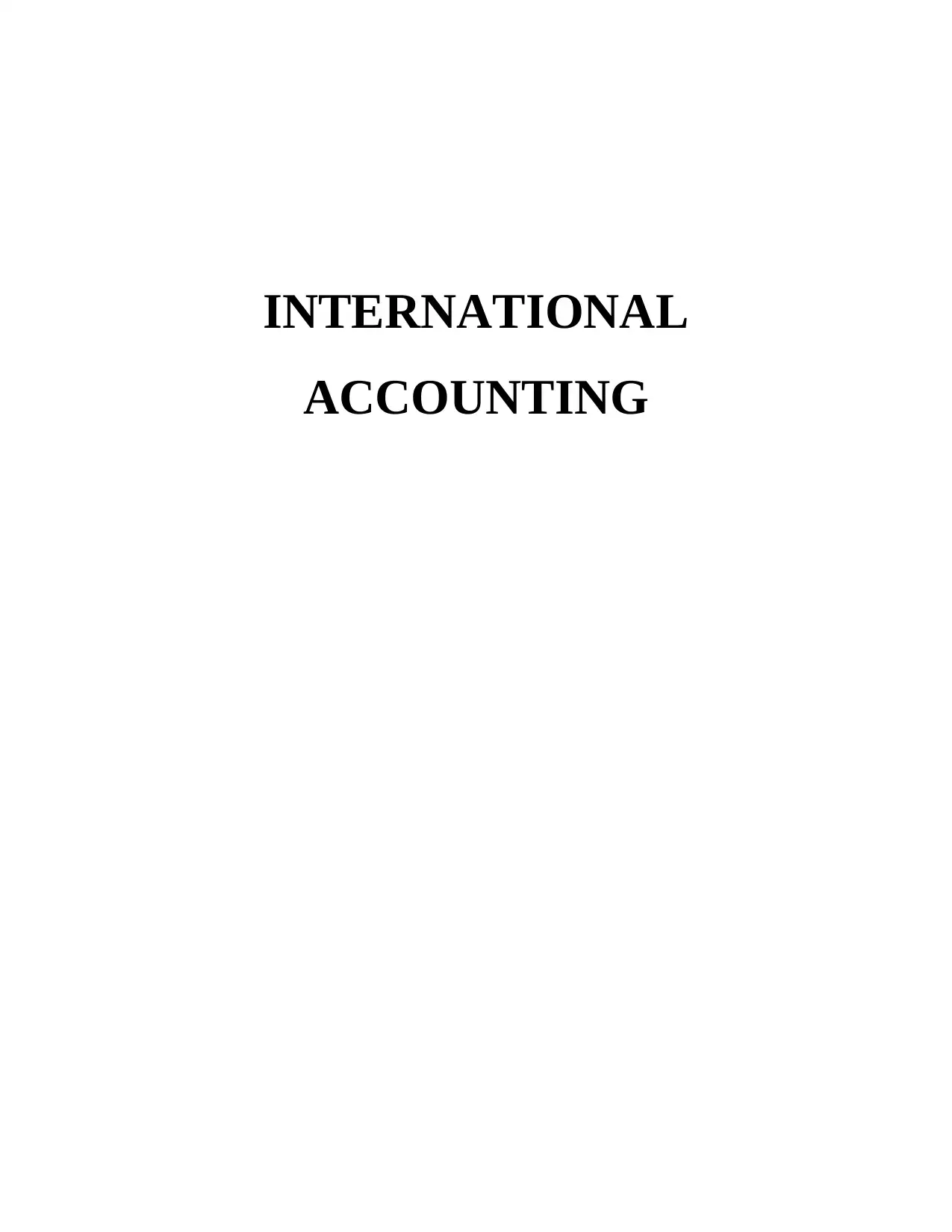
INTERNATIONAL
ACCOUNTING
ACCOUNTING
Secure Best Marks with AI Grader
Need help grading? Try our AI Grader for instant feedback on your assignments.
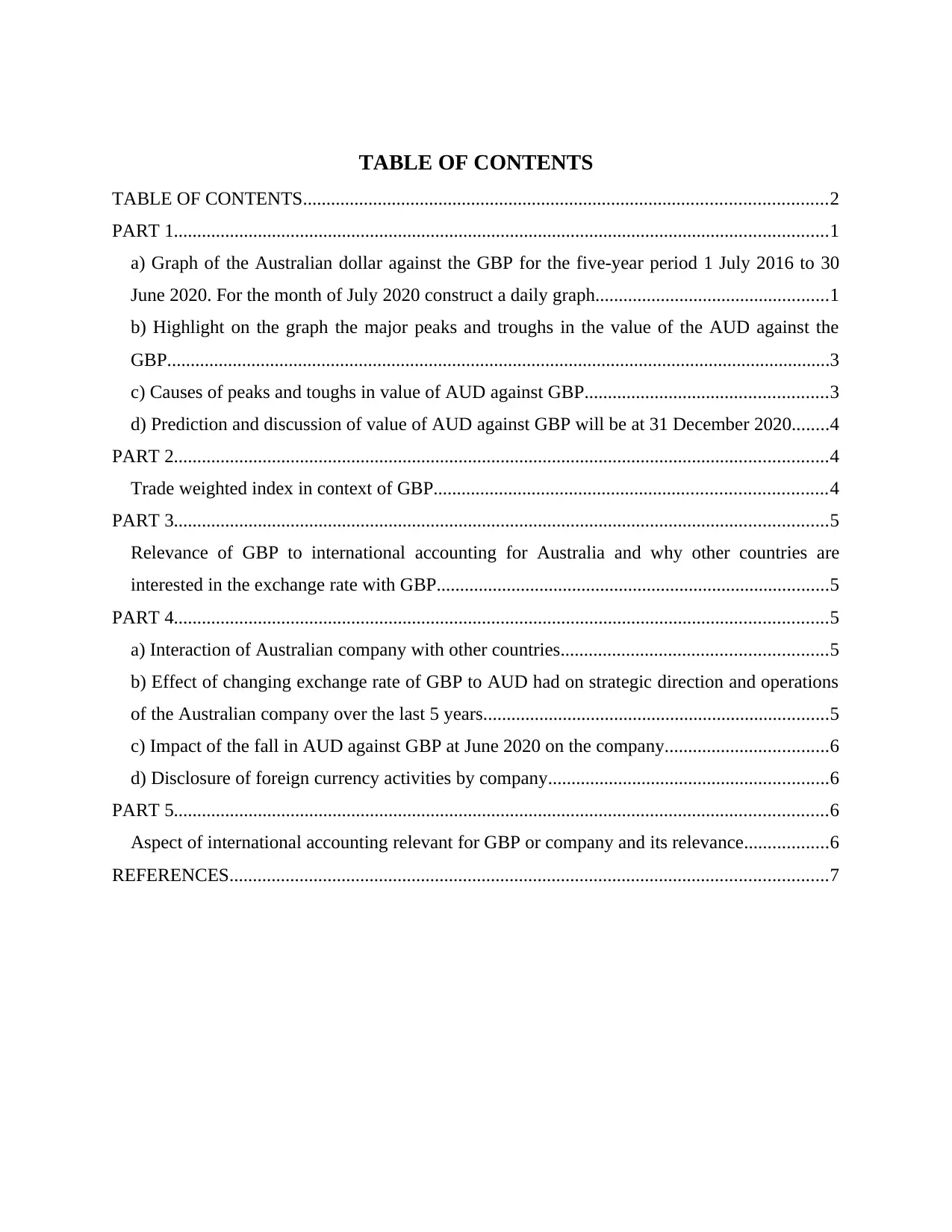
TABLE OF CONTENTS
TABLE OF CONTENTS................................................................................................................2
PART 1............................................................................................................................................1
a) Graph of the Australian dollar against the GBP for the five-year period 1 July 2016 to 30
June 2020. For the month of July 2020 construct a daily graph..................................................1
b) Highlight on the graph the major peaks and troughs in the value of the AUD against the
GBP..............................................................................................................................................3
c) Causes of peaks and toughs in value of AUD against GBP....................................................3
d) Prediction and discussion of value of AUD against GBP will be at 31 December 2020........4
PART 2............................................................................................................................................4
Trade weighted index in context of GBP....................................................................................4
PART 3............................................................................................................................................5
Relevance of GBP to international accounting for Australia and why other countries are
interested in the exchange rate with GBP....................................................................................5
PART 4............................................................................................................................................5
a) Interaction of Australian company with other countries.........................................................5
b) Effect of changing exchange rate of GBP to AUD had on strategic direction and operations
of the Australian company over the last 5 years..........................................................................5
c) Impact of the fall in AUD against GBP at June 2020 on the company...................................6
d) Disclosure of foreign currency activities by company............................................................6
PART 5............................................................................................................................................6
Aspect of international accounting relevant for GBP or company and its relevance..................6
REFERENCES................................................................................................................................7
TABLE OF CONTENTS................................................................................................................2
PART 1............................................................................................................................................1
a) Graph of the Australian dollar against the GBP for the five-year period 1 July 2016 to 30
June 2020. For the month of July 2020 construct a daily graph..................................................1
b) Highlight on the graph the major peaks and troughs in the value of the AUD against the
GBP..............................................................................................................................................3
c) Causes of peaks and toughs in value of AUD against GBP....................................................3
d) Prediction and discussion of value of AUD against GBP will be at 31 December 2020........4
PART 2............................................................................................................................................4
Trade weighted index in context of GBP....................................................................................4
PART 3............................................................................................................................................5
Relevance of GBP to international accounting for Australia and why other countries are
interested in the exchange rate with GBP....................................................................................5
PART 4............................................................................................................................................5
a) Interaction of Australian company with other countries.........................................................5
b) Effect of changing exchange rate of GBP to AUD had on strategic direction and operations
of the Australian company over the last 5 years..........................................................................5
c) Impact of the fall in AUD against GBP at June 2020 on the company...................................6
d) Disclosure of foreign currency activities by company............................................................6
PART 5............................................................................................................................................6
Aspect of international accounting relevant for GBP or company and its relevance..................6
REFERENCES................................................................................................................................7
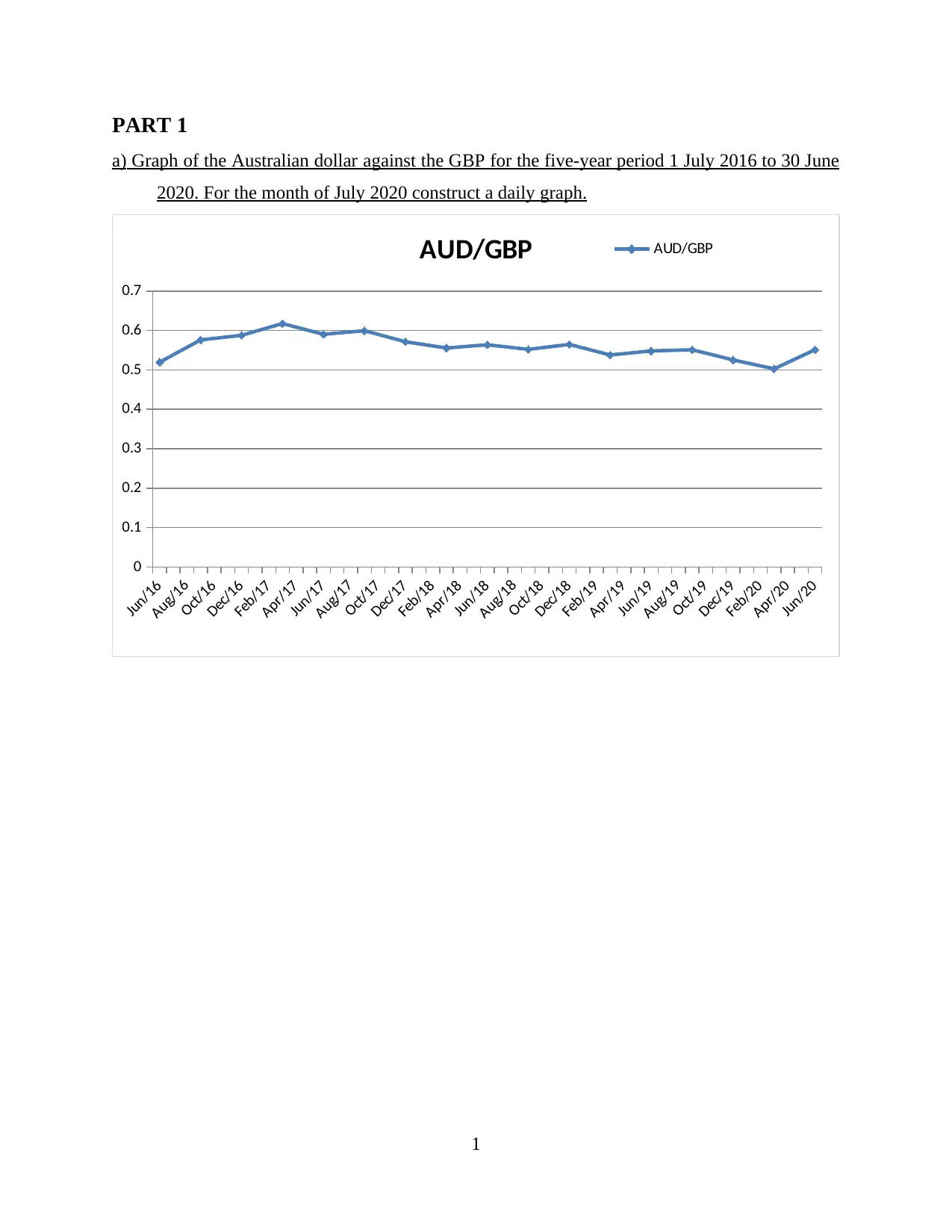
PART 1
a) Graph of the Australian dollar against the GBP for the five-year period 1 July 2016 to 30 June
2020. For the month of July 2020 construct a daily graph.
Jun/16
Aug/16
Oct/16
Dec/16
Feb/17
Apr/17
Jun/17
Aug/17
Oct/17
Dec/17
Feb/18
Apr/18
Jun/18
Aug/18
Oct/18
Dec/18
Feb/19
Apr/19
Jun/19
Aug/19
Oct/19
Dec/19
Feb/20
Apr/20
Jun/20
0
0.1
0.2
0.3
0.4
0.5
0.6
0.7
AUD/GBP AUD/GBP
1
a) Graph of the Australian dollar against the GBP for the five-year period 1 July 2016 to 30 June
2020. For the month of July 2020 construct a daily graph.
Jun/16
Aug/16
Oct/16
Dec/16
Feb/17
Apr/17
Jun/17
Aug/17
Oct/17
Dec/17
Feb/18
Apr/18
Jun/18
Aug/18
Oct/18
Dec/18
Feb/19
Apr/19
Jun/19
Aug/19
Oct/19
Dec/19
Feb/20
Apr/20
Jun/20
0
0.1
0.2
0.3
0.4
0.5
0.6
0.7
AUD/GBP AUD/GBP
1
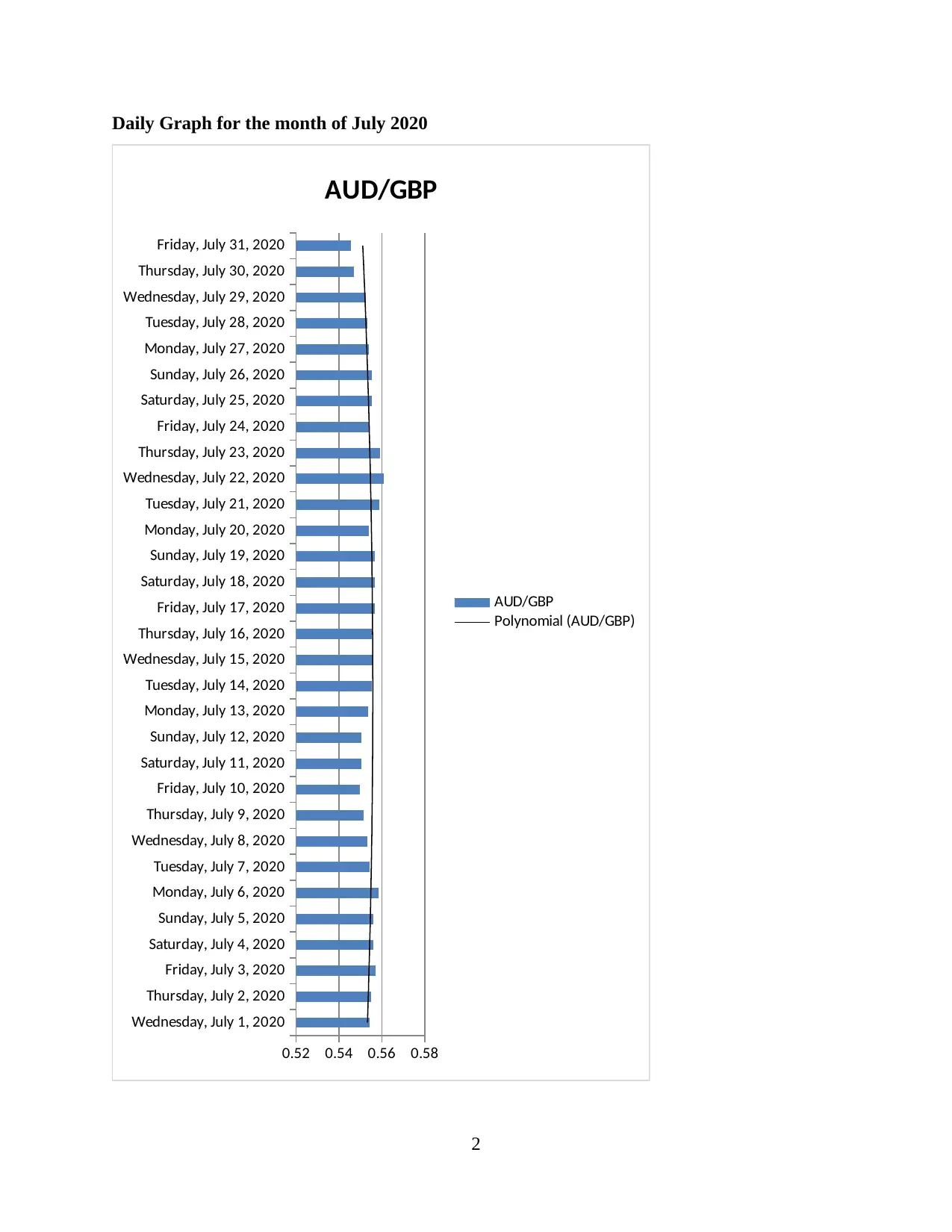
Daily Graph for the month of July 2020
Wednesday, July 1, 2020
Thursday, July 2, 2020
Friday, July 3, 2020
Saturday, July 4, 2020
Sunday, July 5, 2020
Monday, July 6, 2020
Tuesday, July 7, 2020
Wednesday, July 8, 2020
Thursday, July 9, 2020
Friday, July 10, 2020
Saturday, July 11, 2020
Sunday, July 12, 2020
Monday, July 13, 2020
Tuesday, July 14, 2020
Wednesday, July 15, 2020
Thursday, July 16, 2020
Friday, July 17, 2020
Saturday, July 18, 2020
Sunday, July 19, 2020
Monday, July 20, 2020
Tuesday, July 21, 2020
Wednesday, July 22, 2020
Thursday, July 23, 2020
Friday, July 24, 2020
Saturday, July 25, 2020
Sunday, July 26, 2020
Monday, July 27, 2020
Tuesday, July 28, 2020
Wednesday, July 29, 2020
Thursday, July 30, 2020
Friday, July 31, 2020
0.52 0.54 0.56 0.58
AUD/GBP
AUD/GBP
Polynomial (AUD/GBP)
2
Wednesday, July 1, 2020
Thursday, July 2, 2020
Friday, July 3, 2020
Saturday, July 4, 2020
Sunday, July 5, 2020
Monday, July 6, 2020
Tuesday, July 7, 2020
Wednesday, July 8, 2020
Thursday, July 9, 2020
Friday, July 10, 2020
Saturday, July 11, 2020
Sunday, July 12, 2020
Monday, July 13, 2020
Tuesday, July 14, 2020
Wednesday, July 15, 2020
Thursday, July 16, 2020
Friday, July 17, 2020
Saturday, July 18, 2020
Sunday, July 19, 2020
Monday, July 20, 2020
Tuesday, July 21, 2020
Wednesday, July 22, 2020
Thursday, July 23, 2020
Friday, July 24, 2020
Saturday, July 25, 2020
Sunday, July 26, 2020
Monday, July 27, 2020
Tuesday, July 28, 2020
Wednesday, July 29, 2020
Thursday, July 30, 2020
Friday, July 31, 2020
0.52 0.54 0.56 0.58
AUD/GBP
AUD/GBP
Polynomial (AUD/GBP)
2
Secure Best Marks with AI Grader
Need help grading? Try our AI Grader for instant feedback on your assignments.
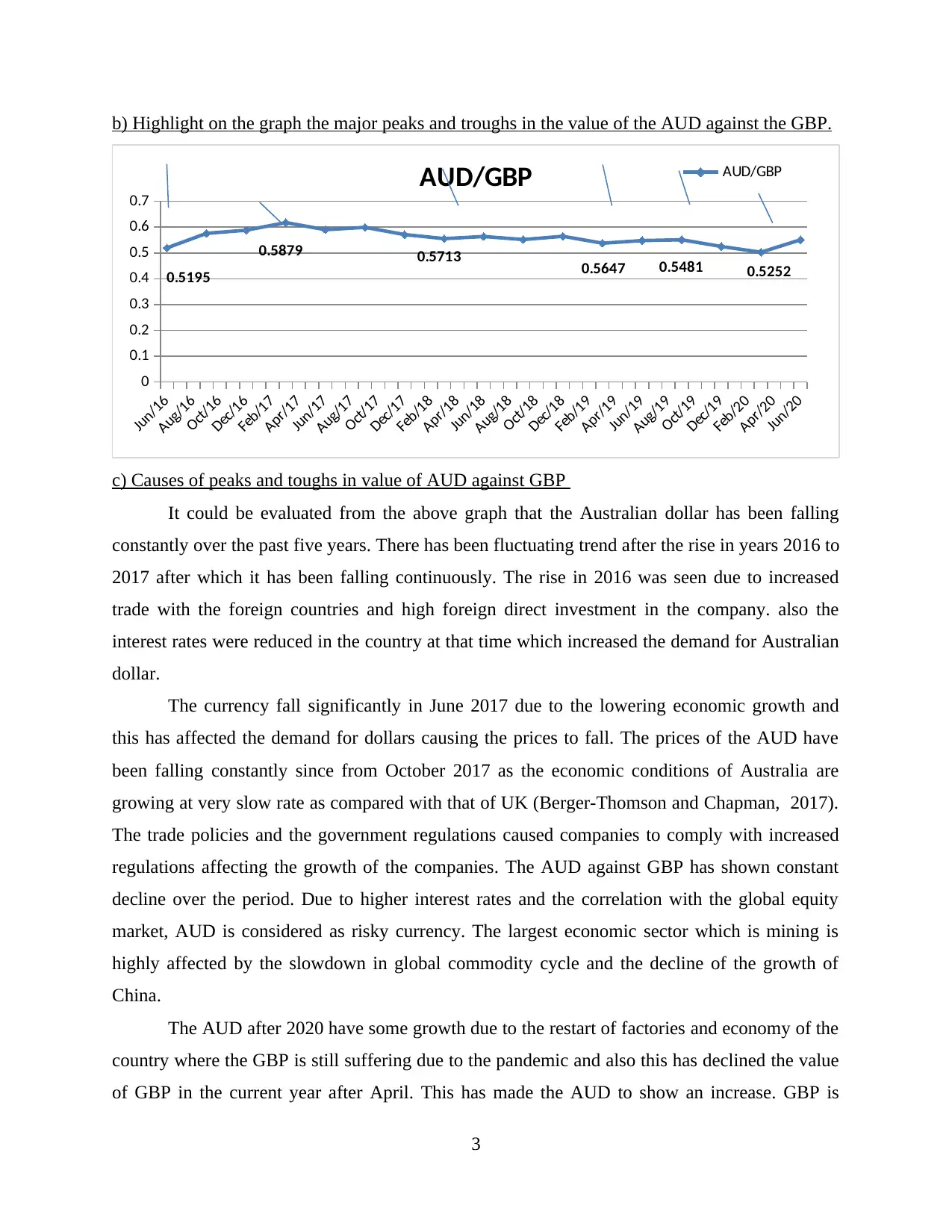
b) Highlight on the graph the major peaks and troughs in the value of the AUD against the GBP.
Jun/16
Aug/16
Oct/16
Dec/16
Feb/17
Apr/17
Jun/17
Aug/17
Oct/17
Dec/17
Feb/18
Apr/18
Jun/18
Aug/18
Oct/18
Dec/18
Feb/19
Apr/19
Jun/19
Aug/19
Oct/19
Dec/19
Feb/20
Apr/20
Jun/20
0
0.1
0.2
0.3
0.4
0.5
0.6
0.7
0.5195
0.5879 0.5713 0.5647 0.5481 0.5252
AUD/GBP AUD/GBP
c) Causes of peaks and toughs in value of AUD against GBP
It could be evaluated from the above graph that the Australian dollar has been falling
constantly over the past five years. There has been fluctuating trend after the rise in years 2016 to
2017 after which it has been falling continuously. The rise in 2016 was seen due to increased
trade with the foreign countries and high foreign direct investment in the company. also the
interest rates were reduced in the country at that time which increased the demand for Australian
dollar.
The currency fall significantly in June 2017 due to the lowering economic growth and
this has affected the demand for dollars causing the prices to fall. The prices of the AUD have
been falling constantly since from October 2017 as the economic conditions of Australia are
growing at very slow rate as compared with that of UK (Berger-Thomson and Chapman, 2017).
The trade policies and the government regulations caused companies to comply with increased
regulations affecting the growth of the companies. The AUD against GBP has shown constant
decline over the period. Due to higher interest rates and the correlation with the global equity
market, AUD is considered as risky currency. The largest economic sector which is mining is
highly affected by the slowdown in global commodity cycle and the decline of the growth of
China.
The AUD after 2020 have some growth due to the restart of factories and economy of the
country where the GBP is still suffering due to the pandemic and also this has declined the value
of GBP in the current year after April. This has made the AUD to show an increase. GBP is
3
Jun/16
Aug/16
Oct/16
Dec/16
Feb/17
Apr/17
Jun/17
Aug/17
Oct/17
Dec/17
Feb/18
Apr/18
Jun/18
Aug/18
Oct/18
Dec/18
Feb/19
Apr/19
Jun/19
Aug/19
Oct/19
Dec/19
Feb/20
Apr/20
Jun/20
0
0.1
0.2
0.3
0.4
0.5
0.6
0.7
0.5195
0.5879 0.5713 0.5647 0.5481 0.5252
AUD/GBP AUD/GBP
c) Causes of peaks and toughs in value of AUD against GBP
It could be evaluated from the above graph that the Australian dollar has been falling
constantly over the past five years. There has been fluctuating trend after the rise in years 2016 to
2017 after which it has been falling continuously. The rise in 2016 was seen due to increased
trade with the foreign countries and high foreign direct investment in the company. also the
interest rates were reduced in the country at that time which increased the demand for Australian
dollar.
The currency fall significantly in June 2017 due to the lowering economic growth and
this has affected the demand for dollars causing the prices to fall. The prices of the AUD have
been falling constantly since from October 2017 as the economic conditions of Australia are
growing at very slow rate as compared with that of UK (Berger-Thomson and Chapman, 2017).
The trade policies and the government regulations caused companies to comply with increased
regulations affecting the growth of the companies. The AUD against GBP has shown constant
decline over the period. Due to higher interest rates and the correlation with the global equity
market, AUD is considered as risky currency. The largest economic sector which is mining is
highly affected by the slowdown in global commodity cycle and the decline of the growth of
China.
The AUD after 2020 have some growth due to the restart of factories and economy of the
country where the GBP is still suffering due to the pandemic and also this has declined the value
of GBP in the current year after April. This has made the AUD to show an increase. GBP is
3
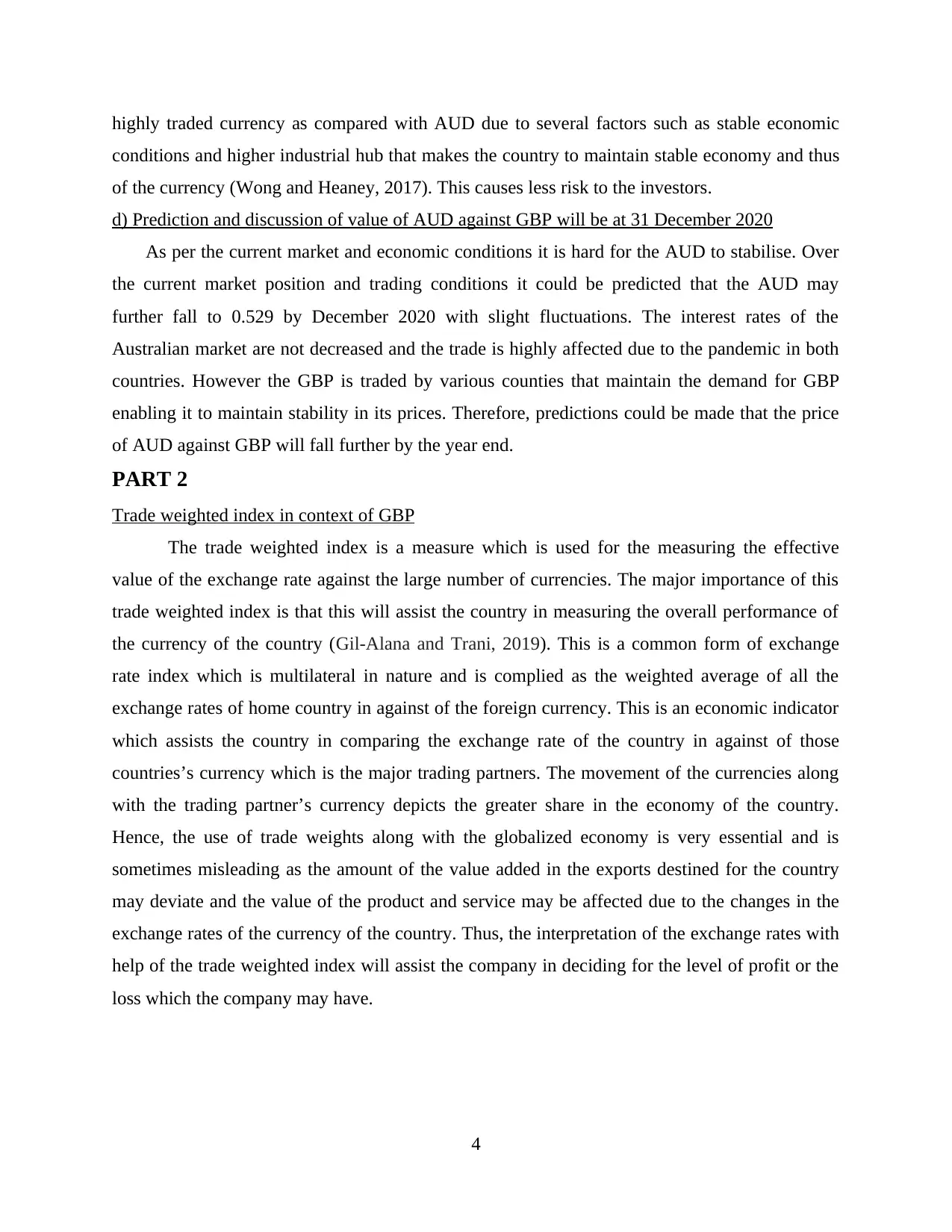
highly traded currency as compared with AUD due to several factors such as stable economic
conditions and higher industrial hub that makes the country to maintain stable economy and thus
of the currency (Wong and Heaney, 2017). This causes less risk to the investors.
d) Prediction and discussion of value of AUD against GBP will be at 31 December 2020
As per the current market and economic conditions it is hard for the AUD to stabilise. Over
the current market position and trading conditions it could be predicted that the AUD may
further fall to 0.529 by December 2020 with slight fluctuations. The interest rates of the
Australian market are not decreased and the trade is highly affected due to the pandemic in both
countries. However the GBP is traded by various counties that maintain the demand for GBP
enabling it to maintain stability in its prices. Therefore, predictions could be made that the price
of AUD against GBP will fall further by the year end.
PART 2
Trade weighted index in context of GBP
The trade weighted index is a measure which is used for the measuring the effective
value of the exchange rate against the large number of currencies. The major importance of this
trade weighted index is that this will assist the country in measuring the overall performance of
the currency of the country (Gil-Alana and Trani, 2019). This is a common form of exchange
rate index which is multilateral in nature and is complied as the weighted average of all the
exchange rates of home country in against of the foreign currency. This is an economic indicator
which assists the country in comparing the exchange rate of the country in against of those
countries’s currency which is the major trading partners. The movement of the currencies along
with the trading partner’s currency depicts the greater share in the economy of the country.
Hence, the use of trade weights along with the globalized economy is very essential and is
sometimes misleading as the amount of the value added in the exports destined for the country
may deviate and the value of the product and service may be affected due to the changes in the
exchange rates of the currency of the country. Thus, the interpretation of the exchange rates with
help of the trade weighted index will assist the company in deciding for the level of profit or the
loss which the company may have.
4
conditions and higher industrial hub that makes the country to maintain stable economy and thus
of the currency (Wong and Heaney, 2017). This causes less risk to the investors.
d) Prediction and discussion of value of AUD against GBP will be at 31 December 2020
As per the current market and economic conditions it is hard for the AUD to stabilise. Over
the current market position and trading conditions it could be predicted that the AUD may
further fall to 0.529 by December 2020 with slight fluctuations. The interest rates of the
Australian market are not decreased and the trade is highly affected due to the pandemic in both
countries. However the GBP is traded by various counties that maintain the demand for GBP
enabling it to maintain stability in its prices. Therefore, predictions could be made that the price
of AUD against GBP will fall further by the year end.
PART 2
Trade weighted index in context of GBP
The trade weighted index is a measure which is used for the measuring the effective
value of the exchange rate against the large number of currencies. The major importance of this
trade weighted index is that this will assist the country in measuring the overall performance of
the currency of the country (Gil-Alana and Trani, 2019). This is a common form of exchange
rate index which is multilateral in nature and is complied as the weighted average of all the
exchange rates of home country in against of the foreign currency. This is an economic indicator
which assists the country in comparing the exchange rate of the country in against of those
countries’s currency which is the major trading partners. The movement of the currencies along
with the trading partner’s currency depicts the greater share in the economy of the country.
Hence, the use of trade weights along with the globalized economy is very essential and is
sometimes misleading as the amount of the value added in the exports destined for the country
may deviate and the value of the product and service may be affected due to the changes in the
exchange rates of the currency of the country. Thus, the interpretation of the exchange rates with
help of the trade weighted index will assist the company in deciding for the level of profit or the
loss which the company may have.
4
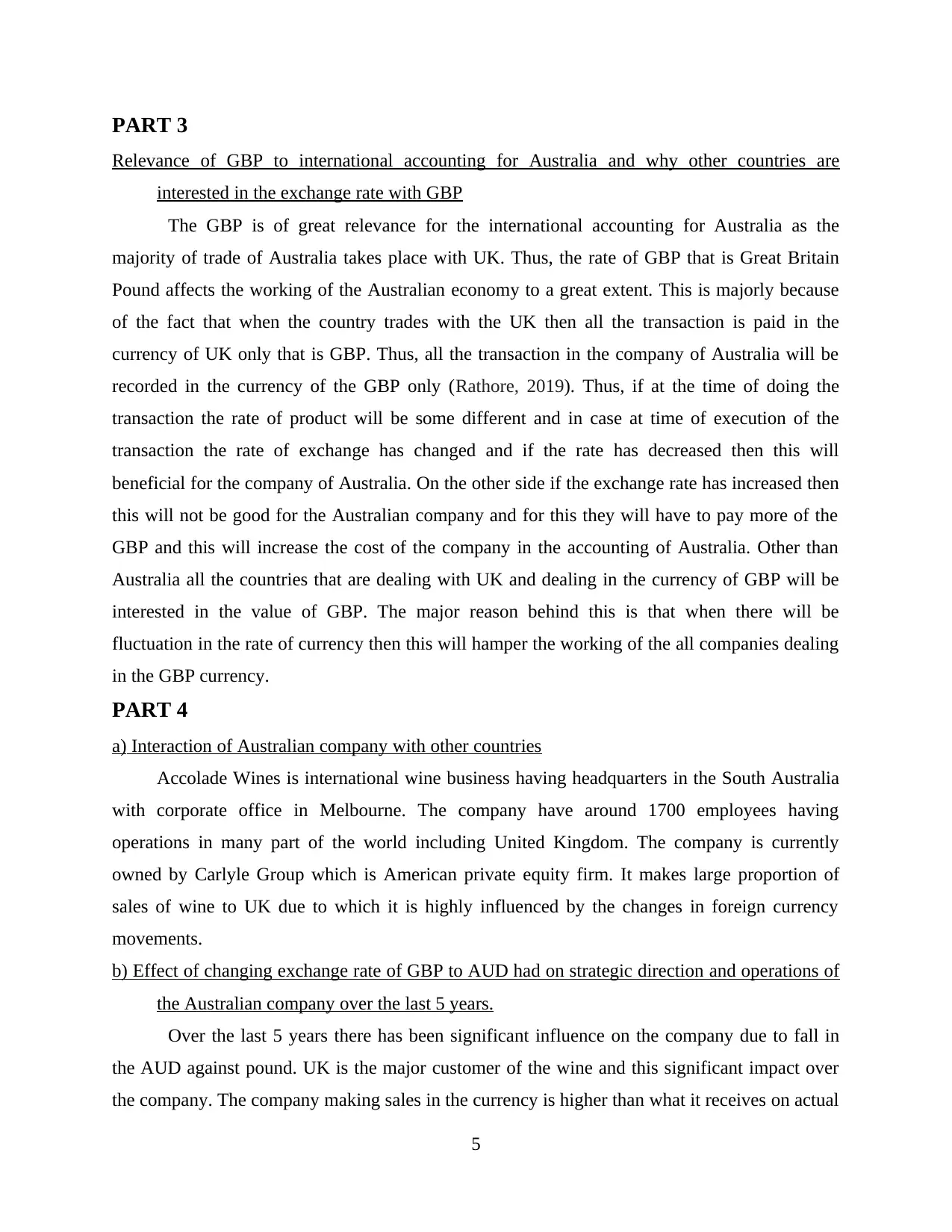
PART 3
Relevance of GBP to international accounting for Australia and why other countries are
interested in the exchange rate with GBP
The GBP is of great relevance for the international accounting for Australia as the
majority of trade of Australia takes place with UK. Thus, the rate of GBP that is Great Britain
Pound affects the working of the Australian economy to a great extent. This is majorly because
of the fact that when the country trades with the UK then all the transaction is paid in the
currency of UK only that is GBP. Thus, all the transaction in the company of Australia will be
recorded in the currency of the GBP only (Rathore, 2019). Thus, if at the time of doing the
transaction the rate of product will be some different and in case at time of execution of the
transaction the rate of exchange has changed and if the rate has decreased then this will
beneficial for the company of Australia. On the other side if the exchange rate has increased then
this will not be good for the Australian company and for this they will have to pay more of the
GBP and this will increase the cost of the company in the accounting of Australia. Other than
Australia all the countries that are dealing with UK and dealing in the currency of GBP will be
interested in the value of GBP. The major reason behind this is that when there will be
fluctuation in the rate of currency then this will hamper the working of the all companies dealing
in the GBP currency.
PART 4
a) Interaction of Australian company with other countries
Accolade Wines is international wine business having headquarters in the South Australia
with corporate office in Melbourne. The company have around 1700 employees having
operations in many part of the world including United Kingdom. The company is currently
owned by Carlyle Group which is American private equity firm. It makes large proportion of
sales of wine to UK due to which it is highly influenced by the changes in foreign currency
movements.
b) Effect of changing exchange rate of GBP to AUD had on strategic direction and operations of
the Australian company over the last 5 years.
Over the last 5 years there has been significant influence on the company due to fall in
the AUD against pound. UK is the major customer of the wine and this significant impact over
the company. The company making sales in the currency is higher than what it receives on actual
5
Relevance of GBP to international accounting for Australia and why other countries are
interested in the exchange rate with GBP
The GBP is of great relevance for the international accounting for Australia as the
majority of trade of Australia takes place with UK. Thus, the rate of GBP that is Great Britain
Pound affects the working of the Australian economy to a great extent. This is majorly because
of the fact that when the country trades with the UK then all the transaction is paid in the
currency of UK only that is GBP. Thus, all the transaction in the company of Australia will be
recorded in the currency of the GBP only (Rathore, 2019). Thus, if at the time of doing the
transaction the rate of product will be some different and in case at time of execution of the
transaction the rate of exchange has changed and if the rate has decreased then this will
beneficial for the company of Australia. On the other side if the exchange rate has increased then
this will not be good for the Australian company and for this they will have to pay more of the
GBP and this will increase the cost of the company in the accounting of Australia. Other than
Australia all the countries that are dealing with UK and dealing in the currency of GBP will be
interested in the value of GBP. The major reason behind this is that when there will be
fluctuation in the rate of currency then this will hamper the working of the all companies dealing
in the GBP currency.
PART 4
a) Interaction of Australian company with other countries
Accolade Wines is international wine business having headquarters in the South Australia
with corporate office in Melbourne. The company have around 1700 employees having
operations in many part of the world including United Kingdom. The company is currently
owned by Carlyle Group which is American private equity firm. It makes large proportion of
sales of wine to UK due to which it is highly influenced by the changes in foreign currency
movements.
b) Effect of changing exchange rate of GBP to AUD had on strategic direction and operations of
the Australian company over the last 5 years.
Over the last 5 years there has been significant influence on the company due to fall in
the AUD against pound. UK is the major customer of the wine and this significant impact over
the company. The company making sales in the currency is higher than what it receives on actual
5
Paraphrase This Document
Need a fresh take? Get an instant paraphrase of this document with our AI Paraphraser
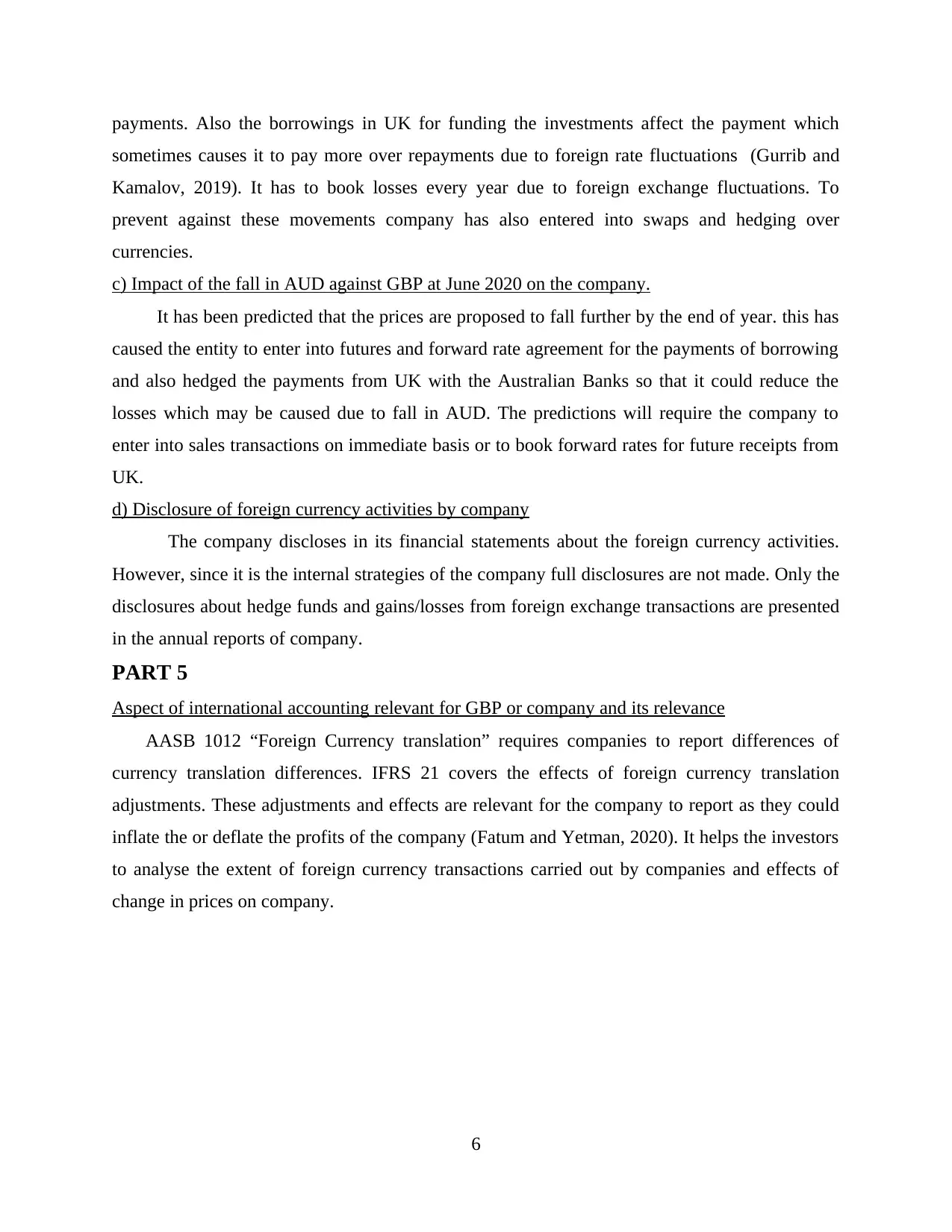
payments. Also the borrowings in UK for funding the investments affect the payment which
sometimes causes it to pay more over repayments due to foreign rate fluctuations (Gurrib and
Kamalov, 2019). It has to book losses every year due to foreign exchange fluctuations. To
prevent against these movements company has also entered into swaps and hedging over
currencies.
c) Impact of the fall in AUD against GBP at June 2020 on the company.
It has been predicted that the prices are proposed to fall further by the end of year. this has
caused the entity to enter into futures and forward rate agreement for the payments of borrowing
and also hedged the payments from UK with the Australian Banks so that it could reduce the
losses which may be caused due to fall in AUD. The predictions will require the company to
enter into sales transactions on immediate basis or to book forward rates for future receipts from
UK.
d) Disclosure of foreign currency activities by company
The company discloses in its financial statements about the foreign currency activities.
However, since it is the internal strategies of the company full disclosures are not made. Only the
disclosures about hedge funds and gains/losses from foreign exchange transactions are presented
in the annual reports of company.
PART 5
Aspect of international accounting relevant for GBP or company and its relevance
AASB 1012 “Foreign Currency translation” requires companies to report differences of
currency translation differences. IFRS 21 covers the effects of foreign currency translation
adjustments. These adjustments and effects are relevant for the company to report as they could
inflate the or deflate the profits of the company (Fatum and Yetman, 2020). It helps the investors
to analyse the extent of foreign currency transactions carried out by companies and effects of
change in prices on company.
6
sometimes causes it to pay more over repayments due to foreign rate fluctuations (Gurrib and
Kamalov, 2019). It has to book losses every year due to foreign exchange fluctuations. To
prevent against these movements company has also entered into swaps and hedging over
currencies.
c) Impact of the fall in AUD against GBP at June 2020 on the company.
It has been predicted that the prices are proposed to fall further by the end of year. this has
caused the entity to enter into futures and forward rate agreement for the payments of borrowing
and also hedged the payments from UK with the Australian Banks so that it could reduce the
losses which may be caused due to fall in AUD. The predictions will require the company to
enter into sales transactions on immediate basis or to book forward rates for future receipts from
UK.
d) Disclosure of foreign currency activities by company
The company discloses in its financial statements about the foreign currency activities.
However, since it is the internal strategies of the company full disclosures are not made. Only the
disclosures about hedge funds and gains/losses from foreign exchange transactions are presented
in the annual reports of company.
PART 5
Aspect of international accounting relevant for GBP or company and its relevance
AASB 1012 “Foreign Currency translation” requires companies to report differences of
currency translation differences. IFRS 21 covers the effects of foreign currency translation
adjustments. These adjustments and effects are relevant for the company to report as they could
inflate the or deflate the profits of the company (Fatum and Yetman, 2020). It helps the investors
to analyse the extent of foreign currency transactions carried out by companies and effects of
change in prices on company.
6
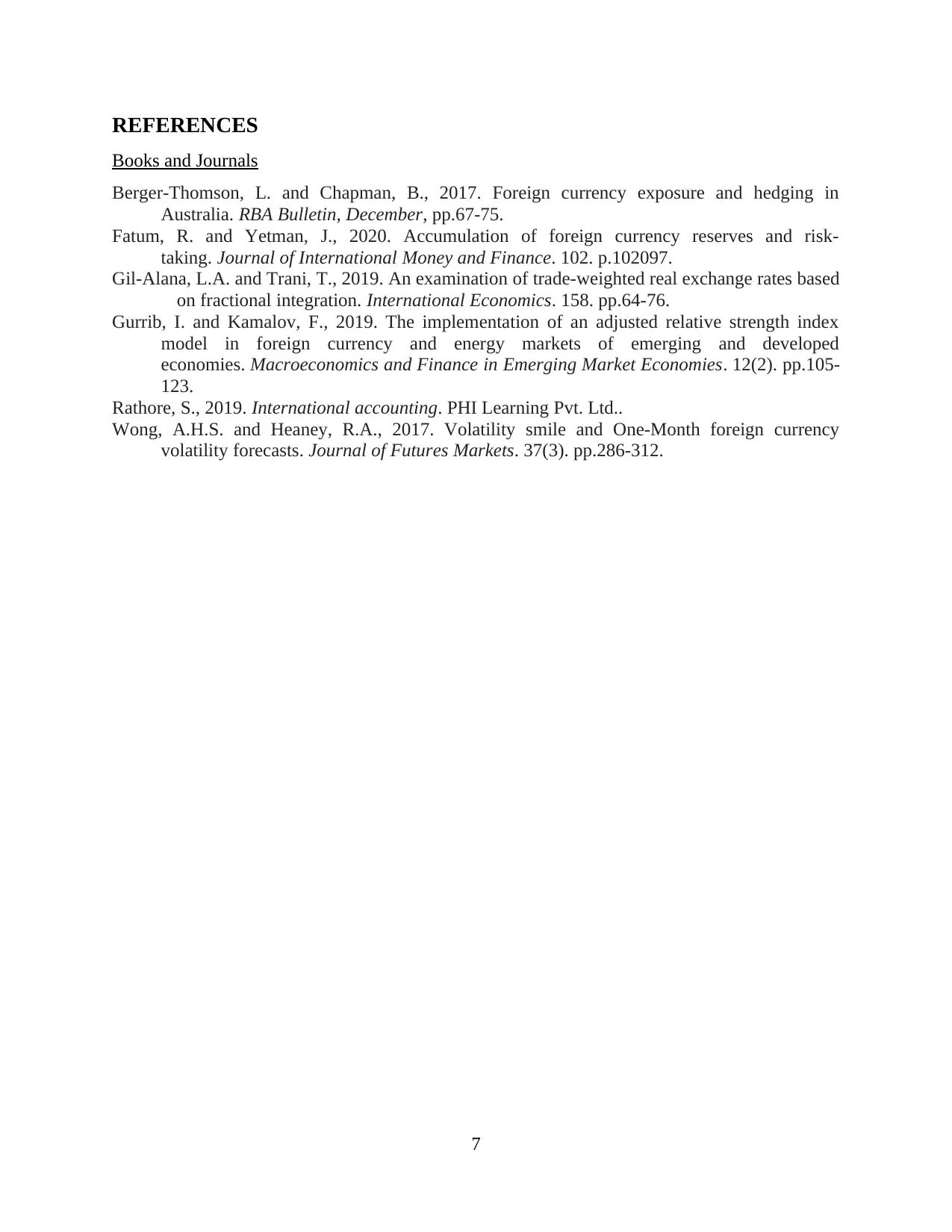
REFERENCES
Books and Journals
Berger-Thomson, L. and Chapman, B., 2017. Foreign currency exposure and hedging in
Australia. RBA Bulletin, December, pp.67-75.
Fatum, R. and Yetman, J., 2020. Accumulation of foreign currency reserves and risk-
taking. Journal of International Money and Finance. 102. p.102097.
Gil-Alana, L.A. and Trani, T., 2019. An examination of trade-weighted real exchange rates based
on fractional integration. International Economics. 158. pp.64-76.
Gurrib, I. and Kamalov, F., 2019. The implementation of an adjusted relative strength index
model in foreign currency and energy markets of emerging and developed
economies. Macroeconomics and Finance in Emerging Market Economies. 12(2). pp.105-
123.
Rathore, S., 2019. International accounting. PHI Learning Pvt. Ltd..
Wong, A.H.S. and Heaney, R.A., 2017. Volatility smile and One‐Month foreign currency
volatility forecasts. Journal of Futures Markets. 37(3). pp.286-312.
7
Books and Journals
Berger-Thomson, L. and Chapman, B., 2017. Foreign currency exposure and hedging in
Australia. RBA Bulletin, December, pp.67-75.
Fatum, R. and Yetman, J., 2020. Accumulation of foreign currency reserves and risk-
taking. Journal of International Money and Finance. 102. p.102097.
Gil-Alana, L.A. and Trani, T., 2019. An examination of trade-weighted real exchange rates based
on fractional integration. International Economics. 158. pp.64-76.
Gurrib, I. and Kamalov, F., 2019. The implementation of an adjusted relative strength index
model in foreign currency and energy markets of emerging and developed
economies. Macroeconomics and Finance in Emerging Market Economies. 12(2). pp.105-
123.
Rathore, S., 2019. International accounting. PHI Learning Pvt. Ltd..
Wong, A.H.S. and Heaney, R.A., 2017. Volatility smile and One‐Month foreign currency
volatility forecasts. Journal of Futures Markets. 37(3). pp.286-312.
7
1 out of 9
Related Documents
Your All-in-One AI-Powered Toolkit for Academic Success.
+13062052269
info@desklib.com
Available 24*7 on WhatsApp / Email
![[object Object]](/_next/static/media/star-bottom.7253800d.svg)
Unlock your academic potential
© 2024 | Zucol Services PVT LTD | All rights reserved.





